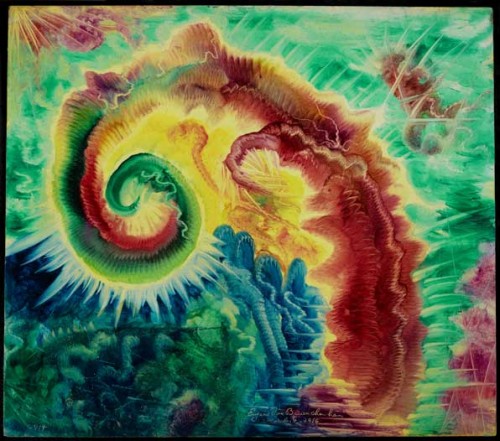“Every fire door stays / closed until fire becomes / the mission”
 Not only are we getting our facts about fire doors, but we’re also finding out that Fern City is shaped like a fish bone, finding everywhere a pinhole of light, finding that a shimmer on fingertips is not fireflies (but War is like Go), finding that you are the kind of grasshopper I need strapped to my back, that all my follywise runts are on the rope, and that all of Paris is wearing itchy periwigs. So where do we find all this? In the new issue of So and So Magazine, featuring Michael Carr, Feng Sun Chen, Elisa Gabbert, Lily Ladewig, Guillermo Parra, Nicole Mauro, and Nate Pritts. Check it out.
Not only are we getting our facts about fire doors, but we’re also finding out that Fern City is shaped like a fish bone, finding everywhere a pinhole of light, finding that a shimmer on fingertips is not fireflies (but War is like Go), finding that you are the kind of grasshopper I need strapped to my back, that all my follywise runts are on the rope, and that all of Paris is wearing itchy periwigs. So where do we find all this? In the new issue of So and So Magazine, featuring Michael Carr, Feng Sun Chen, Elisa Gabbert, Lily Ladewig, Guillermo Parra, Nicole Mauro, and Nate Pritts. Check it out.
June 7th, 2010 / 2:18 pm
WORLD PREMIERE: THE HOUSE THAT JOEY BUILT
Presented by The Agriculture Reader, in celebration of the release of issue #4, which is now available for purchase.
THE OUTSIDERS
Have you been to/do you know about the American Visionary Art Museum? It’s in Baltimore. It features art by outsider artists. In cavalier/casual conversation one might say “art by the insane.” (edit: To be clear, I do not mean to suggest that everyone whose art is exhibited at AVAM was actually insane.) I went there once, a while ago. It came up in conversation the other day–I had forgotten. They have Darger stuff in their permanent collection, I believe. If you’re anywhere near there, go there.
And then think about whether it changes your appreciation of the art if you are told that the people who made it were in some cases mentally unbalanced. (How different is that from MoMA or LACMA?) Is it fucked-up/exploitative to be kind of especially interested in art created by the psychological disturbed? Is that different from collecting the clown paintings of John Wayne Gacy? Hey look, here’s a picture of Gacy with Rosalynn Carter.
image by Eugene Von Bruenchenhein
Illustrating McCarthy and Melville

page 67: He took off the shirt. It stuck to the skin and a yellow pus ran. His arm was swollen to the size of his thigh and it was garishly discolored and small worms worked in the open wound.
Remember how Zak Smith did that cool illustration of Gravity’s Rainbow? Well now he’s doing Blood Meridian as a collaborative project with Sean McCarthy, John Mejias, Craig Taylor, Shawn Cheng, and Matt Wiegle.
Also, Matt Kish is doing one for Moby Dick:

Page 048 : Queequeg was George Washington cannibalistically developed.
Length Matters

On several recent occasions, writers have apologized for sending me “long” stories as if we were exchanging contraband in the form of stories longer than 500 words. To give you a sense of how sad this length sensitivity has gotten, a grand writer apologized for sending me a 3,500 word story. Call me crazy, but a 3,500 word story is not a long story. It is a short short story.
I’ve also heard people complain about the length of Joshua Cohen’s Witz, which at 800 pages is certainly longer than the average book, or David Foster Wallace’s Infinite Jest, at more than 1,000 pages, as if the length of these books was an insurmountable obstacle.
A Quick, Late Post on Light in August
 I’m almost finished reading Light in August. It’s my first Faulkner. Starting at roughly the halfway point it grew into one of the most complex novels I’ve ever read; I’d like to write a fattish pamphlet on this book someday. But what I’d like to focus on here, in broad strokes, is a question regarding “how” rather than “what,” of logic and not of contradiction–specifically how Faulkner produces flat characters, that is, flat characters with depth.
I’m almost finished reading Light in August. It’s my first Faulkner. Starting at roughly the halfway point it grew into one of the most complex novels I’ve ever read; I’d like to write a fattish pamphlet on this book someday. But what I’d like to focus on here, in broad strokes, is a question regarding “how” rather than “what,” of logic and not of contradiction–specifically how Faulkner produces flat characters, that is, flat characters with depth.
Until the halfway point I mentioned earlier, I thought that Faulkner’s characters were, if not simple, then unsurprising–I expected, perhaps, the sort of character who would be presented at first as a racist, and would gradually come to light as nothing like one, as the modest guardian of the victimized race. More or less the character that commercial cinema wants us to believe always lurks within any localization of racist discourse. I eventually realized that many of the characters who seemed to me predictable were flat, pure surface depth: characters who function as signs, specific voices with almost automated responses–like binary switches–that present and order their social, political, or economic genealogies. Flat characters can be instruments of social critique, as in a Brechtian drama, or of comedy–a character who can simply be positioned and repositioned, his or her function made iterable and reiterated.
What I couldn’t understand, though, was why they killed the story. Sure, it wasn’t Blackwater, but this was a store that at least half our readers’ kids would have killed to work for, and it was being run by some racist, frat-boy cult, and the suburban teenagers it hired and fired so mercurially were going to grow into adults who thought this was . . . normal? That in the modern American workplace, this sort of Lord-of-the-Flies management strategy was just par for the fucking course?
The two versions of his novel “The Getaway” — Peckinpah’s in 1972 and Roger Donaldson’s 1994 remake — are notoriously watered down and leave out the book’s most interesting feature: an ending in which the two central characters, a bank robber and his wife, descend into a physical and spiritual hell. Indeed. I always wondered why they left out the best and most bizarre part, when the protagonists go to a fabled Mexican haven for criminals and find it’s a nightmarish semi-fascist enclave (surprise!). I love Jim Thompson, have loved him since I was ten or eleven. The Getaway, The Killer Inside Me, The Grifters, Savage Night. Interested to see Michael Winterbottom’s adaptation of The Killer Inside Me, which provoked lots of disgusted walkouts at Sundance. Trailer looks good.
If Alvin Lucier had a Youtube account….
First, the inspiration. Listen to the Alvin Lucier track “I Am Sitting in a Room,” here.
***
Done?
Okay, watch this.
httpv://www.youtube.com/watch?v=jEIzS_27Vt0&feature=related
Now watch what it looks like after 50 uploads and rips:
httpv://www.youtube.com/watch?v=m5hbbsFGDhk&feature=related
And, after the cut, watch what it looks like after 1000 uploads and rips. It’s gorgeous. READ MORE >


